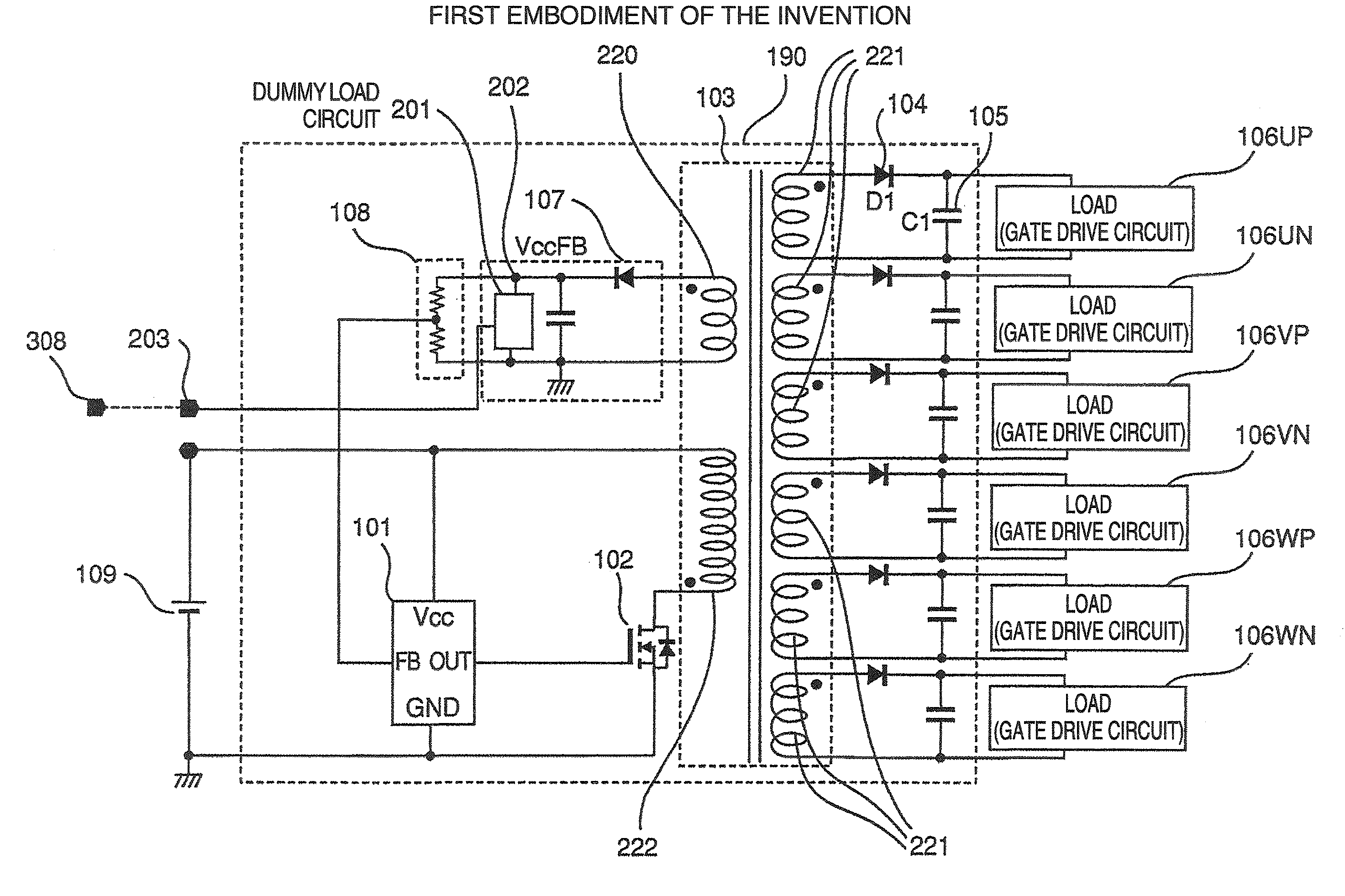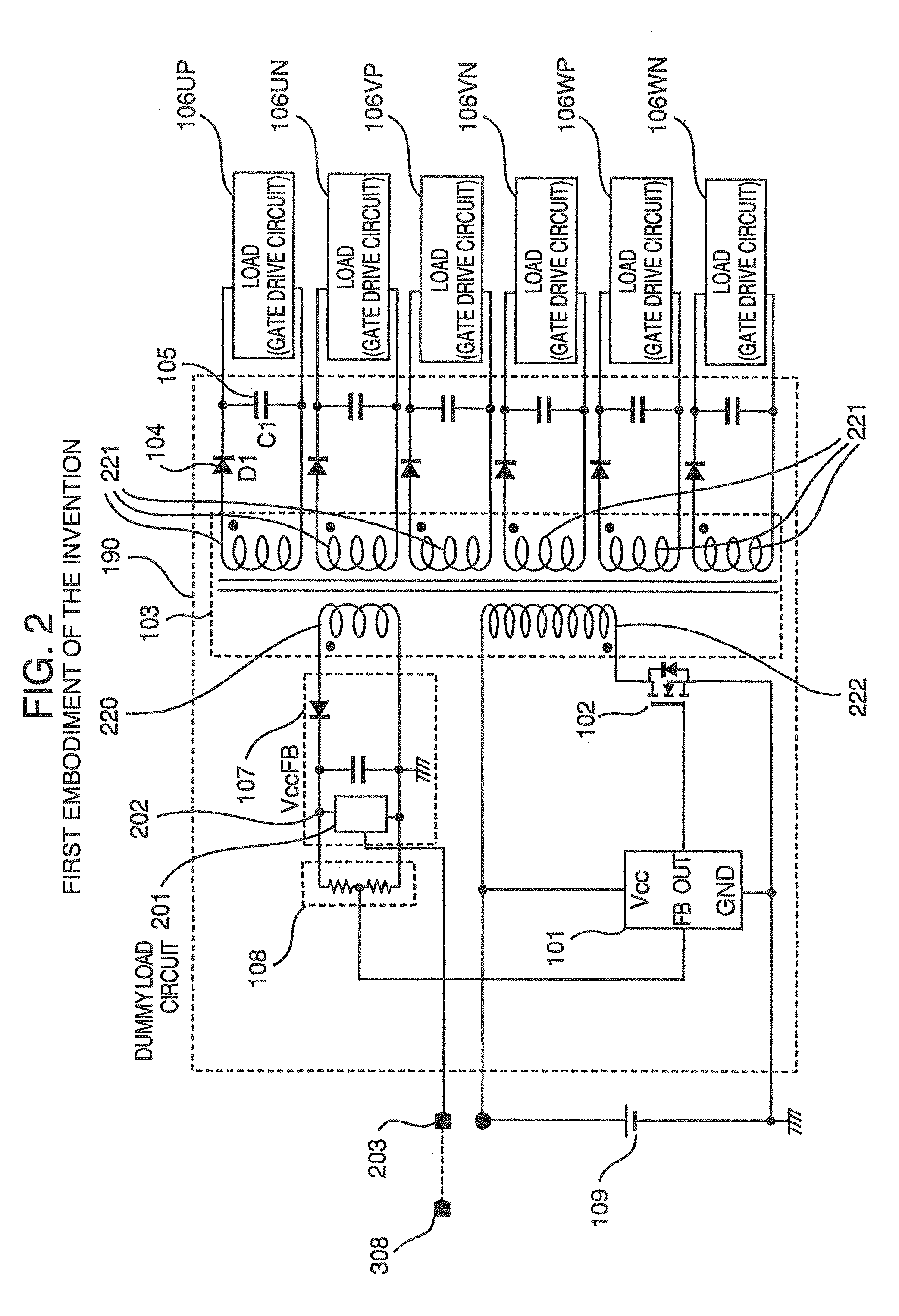Power Supply Circuit and Power Conversion Device
a power supply circuit and power conversion technology, applied in the direction of electric variable regulation, process and machine control, instruments, etc., can solve the problems of deterioration of energy efficiency damage to switching devices, etc., and achieve the effect of suppressing the decrease of output voltag
- Summary
- Abstract
- Description
- Claims
- Application Information
AI Technical Summary
Benefits of technology
Problems solved by technology
Method used
Image
Examples
first embodiment
[0026]A first embodiment of the invention will be described with reference to FIG. 2. FIG. 2 represents a power supply circuit for gate drive circuits. The power supply circuit is a flyback type circuit. The power supply circuit has a transformer 103 for insulating outputs. The transformer 103 has one primary coil 222 and seven secondary coils 220 and 221. One of the secondary coils is a dummy coil 220 for feeding back a power supply voltage, and the other six 221 provide power to gate drive circuits 106. A power supply control IC 101 and a transformer driving MOSFET 102 are located on the primary side of the transformer. The primary coil is connected to a battery 109 outside an inverter through a motor control board. The power supply control IC 101 outputs a PWM signal to the gate of the MOSFET 102 so as to switch a primary current of the transformer 103. On that occasion, the primary current of the transformer 103 can be changed in accordance with the duty ratio of the PWM signal ...
second embodiment
Power Supply Circuit
[0042]A second embodiment of the invention will be described with reference to FIG. 8. This power supply circuit 190 has almost the same configuration as the power supply circuit described in the first embodiment. In the first embodiment, power is also supplied to the dummy load circuit so that the power is also consumed in the dummy load circuit. However, since it works out as long as the dummy load circuit can output a feedback output voltage high enough to prevent the output voltage drop of each gate drive circuit 106, it is therefore desirable that the power consumption in the dummy load circuit is suppressed. To this end, this embodiment differs from the first embodiment as follows. That is, the number of turns of a feedback coil 804 of a transformer 803 is reduced to 1 / 3 of the number of turns of any other secondary coil so as to make the voltage division ratio of a voltage divider circuit 805 three times as high as its original one. That is, the output vol...
third embodiment
Power Supply Circuit
[0048]A third embodiment of the invention will be described with reference to FIG. 10. A power supply circuit in this embodiment is substantially the same as the power supply circuit described in the first embodiment. In the first and second embodiments, a gate signal to be outputted to one upper arm or one lower arm is supplied to the dummy load circuit. However, when the control system of the inverter 301 is changed to a two-phase modulation system, there is a fear that feedback cannot be performed due to use of a signal of one phase which is not operative. Accordingly, in the third embodiment, three signal terminals 1004, 1005 and 1006 connected to the motor control board 302 are provided between an output node 1002 of a feedback output circuit 1003 and the ground. Thus, signals based on gate signal information, for example, carrier frequency information can be outputted directly to a dummy load circuit 1001 so as to improve the reliability of control.
[0049]As...
PUM
 Login to View More
Login to View More Abstract
Description
Claims
Application Information
 Login to View More
Login to View More - R&D
- Intellectual Property
- Life Sciences
- Materials
- Tech Scout
- Unparalleled Data Quality
- Higher Quality Content
- 60% Fewer Hallucinations
Browse by: Latest US Patents, China's latest patents, Technical Efficacy Thesaurus, Application Domain, Technology Topic, Popular Technical Reports.
© 2025 PatSnap. All rights reserved.Legal|Privacy policy|Modern Slavery Act Transparency Statement|Sitemap|About US| Contact US: help@patsnap.com



